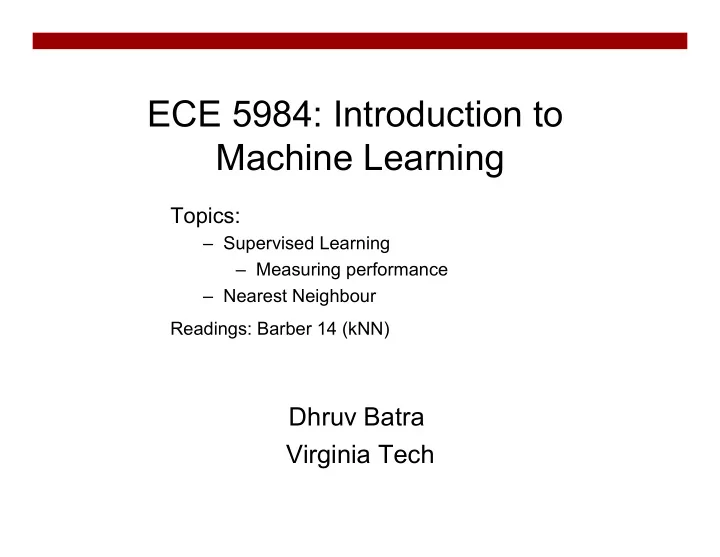

ECE 5984: Introduction to Machine Learning Topics: – Supervised Learning – Measuring performance – Nearest Neighbour Readings: Barber 14 (kNN) Dhruv Batra Virginia Tech
TA: Qing Sun • PhD candidate at ECE department • Research work/interest: – Diverse outputs based on structured probabilistic models – Structured-output prediction (C) Dhruv Batra 2
Recap from last time (C) Dhruv Batra 3
(C) Dhruv Batra 4 Slide Credit: Yaser Abu-Mostapha
Nearest Neighbour • Demo 1 – http://cgm.cs.mcgill.ca/~soss/cs644/projects/perrier/ Nearest.html • Demo 2 – http://www.cs.technion.ac.il/~rani/LocBoost/ (C) Dhruv Batra 5
Spring 2013 Projects • Gender Classification from body proportions – Igor Janjic & Daniel Friedman, Juniors (C) Dhruv Batra 6
Plan for today • Supervised/Inductive Learning – (A bit more on) Loss functions • Nearest Neighbour – Common Distance Metrics – Kernel Classification/Regression – Curse of Dimensionality (C) Dhruv Batra 7
Loss/Error Functions • How do we measure performance? • Regression: – L 2 error • Classification: – #misclassifications – Weighted misclassification via a cost matrix – For 2-class classification: • True Positive, False Positive, True Negative, False Negative – For k-class classification: • Confusion Matrix • ROC curves – http://psych.hanover.edu/JavaTest/SDT/ROC.html (C) Dhruv Batra 8
Nearest Neighbours (C) Dhruv Batra Image Credit: Wikipedia 9
Instance/Memory-based Learning Four things make a memory based learner: • A distance metric • How many nearby neighbors to look at? • A weighting function (optional) • How to fit with the local points? (C) Dhruv Batra Slide Credit: Carlos Guestrin 10
1-Nearest Neighbour Four things make a memory based learner: • A distance metric – Euclidean (and others) • How many nearby neighbors to look at? – 1 • A weighting function (optional) – unused • How to fit with the local points? – Just predict the same output as the nearest neighbour. (C) Dhruv Batra Slide Credit: Carlos Guestrin 11
k-Nearest Neighbour Four things make a memory based learner: • A distance metric – Euclidean (and others) • How many nearby neighbors to look at? – k • A weighting function (optional) – unused • How to fit with the local points? – Just predict the average output among the nearest neighbours. (C) Dhruv Batra Slide Credit: Carlos Guestrin 12
1-NN for Regression Here, this is the closest datapoint y x (C) Dhruv Batra Figure Credit: Carlos Guestrin 13
Multivariate distance metrics Suppose the input vectors x 1 , x 2 , … x N are two dimensional: x 1 = ( x 11 , x 12 ) , x 2 = ( x 21 , x 22 ) , … x N = ( x N1 , x N2 ). One can draw the nearest-neighbor regions in input space. Dist ( x i , x j ) = ( x i1 – x j1 ) 2 + ( x i2 – x j2 ) 2 Dist ( x i , x j ) =( x i1 – x j1 ) 2 +( 3x i2 – 3x j2 ) 2 The relative scalings in the distance metric affect region shapes Slide Credit: Carlos Guestrin
Euclidean distance metric sX D ( x, x 0 ) = σ 2 i ( x i − x 0 i ) 2 Or equivalently, i q i ) T A ( x i − x 0 D ( x, x 0 ) = ( x i − x 0 i ) where A Slide Credit: Carlos Guestrin
Notable distance metrics (and their level sets) Mahalanobis Scaled Euclidian (L 2 ) (non-diagonal A) Slide Credit: Carlos Guestrin
Minkowski distance Image Credit: By Waldir (Based on File:MinkowskiCircles.svg) (C) Dhruv Batra 17 [CC BY-SA 3.0 (http://creativecommons.org/licenses/by-sa/3.0)], via Wikimedia Commons
Notable distance metrics (and their level sets) Scaled Euclidian (L 2 ) L 1 norm (absolute) Mahalanobis (non-diagonal A) L inf (max) norm Slide Credit: Carlos Guestrin
Parametric vs Non-Parametric Models • Does the capacity (size of hypothesis class) grow with size of training data? – Yes = Non-Parametric Models – No = Parametric Models • Example – http://www.theparticle.com/applets/ml/nearest_neighbor/ (C) Dhruv Batra 19
Weighted k-NNs • Neighbors are not all the same
1 vs k Nearest Neighbour (C) Dhruv Batra Image Credit: Ying Wu 21
1 vs k Nearest Neighbour (C) Dhruv Batra Image Credit: Ying Wu 22
1-NN for Regression Here, this is the closest datapoint y x (C) Dhruv Batra Figure Credit: Carlos Guestrin 23
1-NN for Regression • Often bumpy (overfits) (C) Dhruv Batra Figure Credit: Andrew Moore 24
9-NN for Regression • Often bumpy (overfits) (C) Dhruv Batra Figure Credit: Andrew Moore 25
Kernel Regression/Classification Four things make a memory based learner: • A distance metric – Euclidean (and others) • How many nearby neighbors to look at? – All of them • A weighting function (optional) – w i = exp(-d(x i , query) 2 / σ 2 ) – Nearby points to the query are weighted strongly, far points weakly. The σ parameter is the Kernel Width . Very important. • How to fit with the local points? – Predict the weighted average of the outputs predict = Σ w i y i / Σ w i (C) Dhruv Batra Slide Credit: Carlos Guestrin 26
Recommend
More recommend